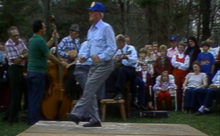History of the Talking Feet film Project
This project came about as a result of a modest research grant from the Smithsonian Institution in 1983. I suggested a project to document the complete step repertories of a few Southern dancers, for archival and reference purposes. In our planning session, Ralph Rinzler urged me to apply to the National Endowment for the Arts to produce a completed film. I applied for and received the grant and started the preliminary field work, including calling many of my acquaintances in the dance community. Early on, I found that the one dancer most important to this project, who was reputed to know nearly 150 steps, was no longer able to dance and that her children had become religious and didn't wish to dance anymore. About this time, I met Ruth Pershing, and as we did the remaining field work, we decided to produce a survey rather than a focused in-depth study of a few dancers. A couple of weeks later, in October 1984, we started our intense two-week trip, filming these dance sequences.
The field trip itinerary was hectic as we tried to get the most out of our two-person film crew. A typical day for the four of us included travel, set-up, interview and dance recording, and then phoning ahead to get the performers and the next location ready. Sometimes when local musicians didn't appear or were not available, I became the dance fiddler or banjo picker. Our dancers certainly sensed the importance of the event and gave their very best. I had sent them all letters after the initial field visit, explaining the project, asking them to think of as many steps as possible and of things to say about their dancing. Our dancers appreciated that someone was attempting to deal with their arts and skills in a serious way. This included paying the artists an honorarium.
Although I had complete confidence in the value of Southern dance, and in our ability to find and record excellent dancers, I had a lot to learn when it came to actually administering such a huge and complex project. The aim was to have full-length shots of complete dances, and some close-ups. I had decided at the outset to use video rather than 16 mm film, largely for economic reasons, and this was possibly a mistake. Our limited budget at the beginning of the project determined that we could only use an industrial-grade camera, which meant that the footage could not be broadcast on TV, which then determined that it was not worth getting a professional editor, which meant that we had to edit it ourselves in the simplest way, for videocassette production.
After the initial October recording trip, we applied for and received another NEA grant to finish the project. After a Smithsonian review of the project, a second recording session was arranged which produced the two dance panels and the demonstration by Rodney Sutton. This session was done with two cameras and recorders (one of the cameras was of broadcast quality) and a full crew over the period of three days.
The editing story is one of trying to coordinate the schedules of the four people involved, of funding hassles, and of countless technical problems, all the way through the final assembly process in California. The resulting start-and-stop editing was certainly part of the reason that it took about 300 hours of studio time over three years to finish the tape.
